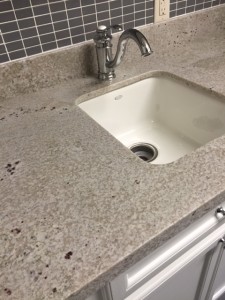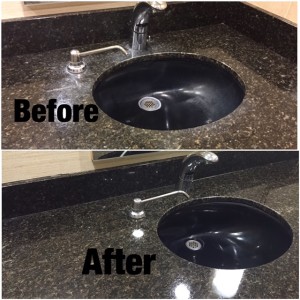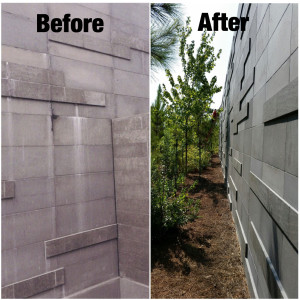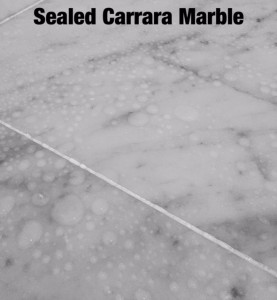Calcium build up around sinks and showers, as well as exterior patios and fountains is one of the most common issues that many homes and buildings constantly battle – so let me assure you that you are not the only one dealing with this problem.

First off, let me say that all stones are not the same: The way you remove calcium deposits from granite is not necessarily the same for marble or travertine. Why is that you ask?
I’m going to get a little technical here, so bare with me: Igneous stones (such as granite and basalt) and Metamorphic stones (such as slate and Schist) are much harder than Calcite stones (such as marble, travertine, and limestone). Igneous and Metamorphic stones generally do not react to acids, while Calcite stones do acid etch. Whichever stone you have, we recommend sealing with penetrating sealer Seal Go® S upon installation and annually after that. Sealing will help with water resistance.
Removing calcium deposits from limestone, marble and travertine
For all stone surfaces such as countertops and showers, we recommend cleaning daily with Akemi Crystal Clean. It safely removes light deposits and soap scum and will not etch (chemically burn) the stone.
Because these stones react to acids, ammonia and alcohol, you cannot use a strong cleaner or vinegar. If your calcium deposits are really built up and are not budging with Crystal Clean, you may need to consider stone restoration. International Stoneworks will use fine abrasives to remove the build up safely, without damaging the stone surface.

Removing calcium deposits from granite and slate
Again, we recommend cleaning with Akemi Crystal Clean. It is a non-aggressive cleaner that can be used daily to prevent calcium build up. If your build up is a little stubborn around the faucets, try cleaning with Crystal Clean and lightly scrubbing with an old, soft toothbrush.
Because most granites do not react (etch) to acids, you could use a stronger cleaner if Crystal Clean is not cutting it. We recommend cleaning with MDR, which stands for Mineral Deposit Remover. (If you are not sure if your granite or slate resists acids, try placing a very small amount of diluted MDR in an inconspicuous area to make sure or call your installer.) Use MDR as directed with a soft brush to remove the calcium build up. Remember: do not use MDR stronger than a 50/50 solution with water and make sure to rinse after cleaning with MDR with clean water.
If you are unsure if MDR is the right product to use on your stone, call us and we would be happy to give you advice.
If cleaning just isn’t enough, International Stoneworks can restore the granite surface and grind off very heavy calcium deposits with our diamond-grinding system. With this restoration technique, we can also restore the shine as well.

For slate patios and decks, if you see white calcium, you can try to clean with MDR and a brush. Please be sure to cover adjacent plants. If MDR is not sufficient, it could be efflorescence leaching from below the stone. Call International Stoneworks if you need advice or if you would prefer for us to handle this project for you.
If you have a more unusual stone refinishing case, call or e-mail us and we will do our best to help find a solution.

